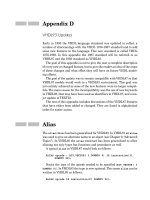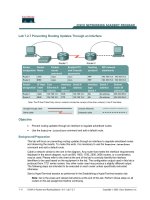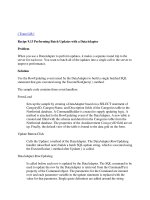VHDL93 Updates
Bạn đang xem bản rút gọn của tài liệu. Xem và tải ngay bản đầy đủ của tài liệu tại đây (155.74 KB, 30 trang )
Appendix D
VHDL93 Updates
Early in 1993 the VHDL language standard was updated to reflect a
number of shortcomings with the VHDL 1076-1987 standard and to add
some new features to the language. This new standard is called VHDL
1076-1993. In this appendix the 1987 standard will be referred to as
VHDL87 and the 1993 standard as VHDL93.
The goal of this appendix is not to give the user a complete description
of every new or changed feature, but to give the reader an idea of the scope
of these changes and what effect they will have on future VHDL model-
ing efforts.
The goal of the update was to remain compatible with VHDL87 so that
VHDL87 models would work in a VHDL93 environment. This goal was
not entirely achieved as some of the new features were no longer compat-
ible. The main reason for the incompatibility was the use of new keywords
in VHDL93, that may have been used as identifiers in VHDL87, and a ma-
jor update of TEXTIO.
The rest of this appendix includes discussions of the VHDL87 features
that have either been added or changed. They are listed in alphabetical
order for easier access.
Alias
The
alias
clause has been generalized for VHDL93. In VHDL87 an
alias
was used to give an alternate name to an object (see Chapter 8, “Advanced
Topics”). In VHDL93 the
alias
construct has been generalized to allow
aliasing not only types but functions and procedures as well.
A typical
alias
in VHDL87 would look as follows:
ALIAS opcode : BIT_VECTOR( 3 DOWNTO 0) IS instruction(31
DOWNTO 28);
Notice the type of the opcode needed to be specified
(BIT_VECTOR( 3
DOWNTO 0))
. In VHDL93 the type is now optional. This same
alias
can be
written in VHDL93 as follows:
ALIAS opcode IS instruction(27 DOWNTO 22);
Not only can objects be aliased in VHDL93 but functions can as well.
To specify a function
alias
requires a subprogram signature specification.
The signature specifies the types of the input parameters as well as the
type of the return parameter. An example is shown here:
ALIAS sub IS “-” [STD_LOGIC_VECTOR, STD_LOGIC_VECTOR,
RETURN STD_LOGIC_VECTOR];
This statement creates an
alias
called
sub
for an overloaded operator
function call that has two
std_logic_vector
input arguments and
returns a
std_logic_vector
.
Attribute Changes
There have been a number of new attributes added to VHDL93. They
reflect added functionality that was either difficult in VHDL87 or not pos-
sible. The following attributes have been added to VHDL93:
`ASCENDING
`DRIVING_VALUE
`IMAGE
`VALUE
`PATHNAME
`INSTANCE_NAME
`SIMPLE_NAME
`ASCENDING In VHDL87 it was tedious to find if a particular range
was ascending or descending. The
`high
and
`low
attributes of the type
had to be compared to determine if the range was truly ascending, a null
range, or a single value. Attribute
`ascending
will return true if the range
is ascending or false if not. An example is shown here:
SUBTYPE descend IS STD_LOGIC_VECTOR( 7 DOWNTO 0);
SUBTYPE ascend IS STD_LOGIC_VECTOR(0 TO 7);
descend`ASCENDING --> false
ascend`ASCENDING --> true
`DRIVING_VALUE In VHDL87 the value of an output port could not
be read. To do this required the port mode of the port to be inout, or the
use of an internal signal. These workarounds caused an increase in
complexity that typically was not warranted and therefore to get around
this inconvenience VHDL93 adds attribute
`driving_value
. Attribute
`driving_value
allows the ability to read the value component of
Appendix D: VHDL93 Updates
450
the resolved value that a particular driver is driving so that it can be
further used in the model. In the example shown here the second com-
ponent instantiation statement would cause an error because input
port a of
U2
is trying to read the current value of
dout
. In VHDL93 the
`driving_value
attribute gets around this problem by reading the driving
value of
dout
.
ENTITY invert IS
PORT( w: IN STD_LOGIC;
dout, doutb : OUT STD_LOGIC);
END invert;
ARCHITECTURE struct OF invert IS
COMPONENT inv
PORT( a : IN STD_LOGIC;
q : OUT STD_LOGIC);
END COMPONENT;
BEGIN
u1 : inv PORT MAP(a => w, q => dout);
--u2 : inv PORT MAP(a => dout, q => doutb);
-- won’t work because port
-- dout cannot be read
u2 : inv PORT MAP(a => dout`DRIVING_VALUE, q => doutb);
-- In VHDL93 this
-- will work
END struct;
`IMAGE AND `VALUE In VHDL87 it was difficult for an error message
to display the actual error value of a signal or a variable in a string. In
VHDL93 the attributes
`IMAGE
and
`VALUE
allow the modeler to convert to
and from type values into string values. Attribute
`IMAGE
converts a type
value into a string, and attribute
`VALUE
converts a string to a type value.
`PATHNAME, `INSTANCE_NAME, AND `SIMPLE_NAME The
other difficulty in VHDL87 of model error reporting was to uniquely
determine exactly which instance of a model was generating a message.
Most VHDL simulators had some mechanism of reporting the instance
information to the modeler, but this information was simulator-specific
and not standard. In VHDL93 three new attributes allow the modeler
access to all parts of the pathname that describes which instance a partic-
ular message is generated from.
■
`SIMPLE_NAME
—
returns a string which is the local name of the
calling entity.
■ `
PATH_NAME
—
returns a string that describes the path to the entity
starting at the root of the design. The
`PATH_NAME
attribute does not
include the names of instantiated entities (
`INSTANCE_NAME
does)
451
Appendix D: VHDL93 Updates
Appendix D: VHDL93 Updates
452
■
`INSTANCE_NAME
—
returns a string that describes the path to the
entity starting at the root of the design. The
`INSTANCE_NAME
attribute also includes the names of instantiated entities. These
entities are specified using a
label@entity(architecture)
syntax.
Bit String Literal
Bit string literals are a handy way in VHDL87 to assign
bit_vector
values. For instance instead of having to explicitly enumerate each bit value
when assigning to a
bit_vector
an octal or hexadecimal notation can
be used as shown here:
SUBTYPE bit16 IS STD_LOGIC_VECTOR(15 DOWNTO 0);
..
VARIABLE bus_value : bit16;
-- these won’t work with VHDL87
bus_value := “0101010101010101”; --- or
bus_value := O”052525”; -- or
bus_value := X”5555”;
In VHDL93 this concept is extended to types
std_logic_vector
.
DELAY_LENGTH Subtype
In VHDL87 most time delays were specified with a type
TIME
. Type
TIME
included negative and positive time values. Most uses of
TIME
required only
positive values of
TIME
. Therefore in VHDL93 a new type in package
STANDARD
has been created, and called
DELAY_LENGTH
.It’s definition is shown here:
SUBTYPE DELAY_LENGTH IS TIME RANGE 0 FS TO TIME`HIGH;
As can be seen this type only includes the positive values of
TIME
.
Compiler writers can optimize the compilation and simulation processes
more with this knowledge.
Direct Instantiation
In VHDL87 an entity from a particular library could not be directly
instantiated in an architecture. A component was declared, instantiated,
and bound to an entity with a configuration. The component could have
been directly or implicitly configured.
In VHDL93 entities can be directly instantiated if they are visible. In
the example here
entity adder
from library work is directly instantiated
and configured in architecture struct.
ENTITY direct IS
PORT( i1 : IN STD_LOGIC;
o1 : OUT STD_LOGIC);
END ENTITY direct;
ARCHITECTURE struct OF direct IS
SIGNAL s1, s2 : STD_LOGIC;
BEGIN
U1 : ENTITY work.adder(behave)
GENERIC MAP(out_delay : delay_type)
PORT MAP(s1, s2, i1, o1);
END ARCHITECTURE struct;
A separate configuration is not necessary as the entity is uniquely
specified. This makes it very easy to describe designs structurally and
with a lot less lines of VHDL code. However, it can make design reuse
more difficult.
Extended Identifiers
In VHDL87 identifiers were limited to only characters a-z, A-Z, and 0-9.
This limited the number of identifiers that could be created. For manually
created VHDL this was not a major problem, but for VHDL that was
translated from some other format this caused some major problems.
Certain netlist formats contain identifiers that consist of operator symbols,
or start with a number. With VHDL93 the extended identifier allows the
user to specify identifiers in a much less restricted manner. Extended
identifiers can start with numbers or contain operator symbols.
Extended identifiers are specified by backslashes (
\..\
) around an
identifier. Extended identifiers can be used anywhere a normal identifier
can be used. An example using extended identifiers is shown here:
entity \74ls163\ is
port (clk : in std_logic;
\1n1\ : in std_logic;
reset : in std_logic;
q1 : out std_logic;
q2 : out std_logic;
q3 : out std_logic);
end \74ls163\;
453
Appendix D: VHDL93 Updates
In this example the entity name (
\74ls163\
), and one of the input ports
(
\1n1\
) are extended identifiers.
File Operations
One of the most welcome additions to VHDL93 is the ability to open
and close files. In VHDL87 files were declared in declarations and opened
implicitly by the elaboration process. VHDL93 adds the ability to specif-
ically open and close files. This allows one subprogram or entity to create
a file which another subprogram or entity can read. In VHDL87 the
modeler would declare a file type to define the type, and later a file decla-
ration that would ultimately open the file. This is shown here:
TYPE int_file IS FILE OF INTEGER; -- VHDL87
--
FILE infile: int_file IS IN “/doug/test/example3”;
-- VHDL87 declares
-- and opens file
In VHDL93 the file type declarations remain the same, but the modeler
has a couple of ways to actually open the file. Probably the most common
will be to call the explicit
FILE_OPEN
procedure as shown here:
PROCEDURE FILE_OPEN(FILE infile: int_file;
EXTERNAL_NAME : IN “/doug/test/example3”;
OPEN_KIND : IN READ_MODE);
This will open the file for reading. If the file cannot be opened for some
reason a runtime error will be generated. An alternate way to open the
file is to call a different version of the
FILE_OPEN
procedure as shown here:
PROCEDURE FILE_OPEN(FILE_STATUS: FILE_OPEN_STATUS;
FILE : int_file;
EXTERNAL_NAME : IN “/doug/test/example3”;
OPEN_KIND : IN READ_MODE);
This procedure returns an output parameter called
FILE_STATUS
that
contains the status of the
FILE_OPEN
procedure call. A status value of
OPEN_OK
means that the file is open and ready to be read. A value of
STATUS_ERROR
means that the file object already has an external file
associated with it. A value of
NAME_ERROR
means that the external file does
not exist. A value of
MODE_ERROR
means that the external file cannot be
opened using the mode passed.
Appendix D: VHDL93 Updates
454
An alternate way of opening the file without calling the explicit
FILE_OPEN
procedure is similar to the method used in VHDL87. This
method uses a file declaration similar to the one in VHDL87, that specifies
the name of the file object, the mode of the file object, and the external
filename to be associated with the file object as shown here:
FILE infile : int_file OPEN READ_MODE IS “/doug/test/
example3”;
This effectively calls the
FILE_OPEN
procedure as follows:
FILE_OPEN(infile, “/doug/test/example3”, READ_MODE);
When a file type declaration of a particular
type_mark
is declared the
following declarations are implicitly declared.
TYPE FT IS FILE OF type_mark;
PROCEDURE FILE_OPEN( FILE F : FT;
EXTERNAL_NAME : IN STRING;
OPEN_KIND : IN FILE_OPEN_KIND :=
READ_MODE);
PROCEDURE FILE_OPEN( STATUS : OUT FILE_OPEN_STATUS;
FILE F : FT;
EXTERNAL_NAME : IN STRING;
OPEN_KIND : IN FILE_OPEN_KIND :=
READ_MODE);
PROCEDURE FILE_CLOSE( FILE F : FT);
PROCEDURE READ( FILE F : FT; VALUE : OUT type_mark);
PROCEDURE WRITE( FILE F : FT; VALUE : OUT type_mark);
PROCEDURE ENDFILE( FILE F : FT) RETURN BOOLEAN;
The file type declaration declares a file of type
type_mark
. With the file
type declaration all of the above procedures are implicitly declared. Once
these procedures are declared they can be used to read and write files of
the
type_mark
.
Foreign Interface
In VHDL87 it was possible to call functions and procedures that were not
described using VHDL. It was possible but limited in scope and not very
well defined. The VHDL93 package standard now contains an attribute
455
Appendix D: VHDL93 Updates
called
FOREIGN
whose value is a string. This string value describes the
interface to the external function, procedure, or entity. The value of this
string is not standardized and depends on the type of the external code
being called. An example might look as follows:
FUNCTION beep( length : INTEGER) IS
ATTRIBUTE FOREIGN OF beep : FUNCTION IS
“sysbeep(length)”;
BEGIN
END FUNCTION beep;
In this example, a function called
beep
is declared that contains a
FOREIGN
attribute. The
FOREIGN
attribute specifies that the body of this
function will be implemented by code other than VHDL. The string value
of the attribute declares the interface expected between function
beep
and
the foreign code to implement the function. However, the string value is
not defined in VHDL93 to be anything more than just a string.
Generate Statement Changes
In a minor addition, VHDL93 adds a declaration section to the generate
statement. Any declarations before the
BEGIN
clause are local only to the
generate statement.
g1: FOR k IN 0 TO 3 GENERATE
SIGNAL reset : STD_LOGIC;
BEGIN
dffx : dff PORT MAP( z(i), reset, clk, z(i + 1));
END GENERATE;
The generate statement above declares local signal
reset
. This signal
is local only to the generate statement.
Globally Static Assignment
VHDL93 adds a new feature that allows globally static values to be
assigned to port maps. In VHDL87 port maps could only bind formal pa-
rameters to signals. In VHDL93 this has been generalized to include ex-
pressions as well. These expressions have to be globally static, or known
at elaboration time.
Appendix D: VHDL93 Updates
456
u1: mux4 PORT MAP( k0 => s0, k1 => s1, k2 => s2, en =>
‘1’, q => outp);
In the example above the value
1
is mapped to port
en
. In VHDL87 a
separate signal would have to be created, assigned to the value
1
, and
then mapped to port
en
.
The globally static value does not have to be just a simple value, it can
be any expression known at compile time that matches the type of the port.
Groups
It is sometimes useful while modeling to declare an attribute that is to
apply to more than one object. Especially in writing synthesizable models
some attributes are useful to describe behavior for an entire section of a
model. In VHDL87 there was no way to describe this type of attribute
structure. VHDL93 has the concept of groups which allows an attribute to
pertain to all objects in the group.
A group starts with a group template declaration such as shown here:
GROUP timing_arc IS (SIGNAL, SIGNAL);
This describes a group template called
timing_arc
that is a group of
two signal objects. After the group template is declared a group declaration
can be declared as shown here:
GROUP clk_to_q : timing_arc(clk, q);
GROUP rst_to_q : timing_arc(rst, q);
GROUP set_to_q : timing_arc(set, q);
These declarations show three separate group declarations named
clk_to_q
,
rst_to_q
, and
set_to_q
. Each of these groups describe a group
object with two signals in the group. Once declared these groups can be
operated on as a single object. For instance, if the following attribute is
declared:
ATTRIBUTE prop_delay IS DELAY_LENGTH;
then the following attributes can be applied to the group.
ATTRIBUTE prop_delay OF clk_to_q : GROUP IS 2.3 NS;
ATTRIBUTE prop_delay OF rst_to_q : GROUP IS 3.1 NS;
ATTRIBUTE prop_delay OF set_to_q : GROUP IS 2.7 NS;
457
Appendix D: VHDL93 Updates
These attributes act on both signals in the group.
Another way to describe a group, especially a group that varies in size,
is shown here:
GROUP timing_arc IS (SIGNAL <>);
This syntax is similar to an unconstrained array and describes a group
consisting of one or more signal objects.
Incremental Binding
In VHDL87 the rules about binding were very restrictive. If a component
was bound in a configuration specification, it could not be bound in a
configuration declaration. This made back-annotation of timing delays
rather difficult because the back annotation program had to generate not
only the generic parameter values, but also the proper entity use clauses.
What the modeler would like to do is pick the proper entity to use with a
configuration specification in the architecture of the containing entity,
and use a configuration declaration to specify the values for the back-
annotated timing.
In VHDL87 this was not possible because the component could be con-
figured in either place, but not both. In VHDL93 the incremental binding
feature allows the modeler to create models that behave as wanted.
An example is shown here:
ENTITY dff IS
GENERIC( delay : TIME;
PORT( din, clock : IN STD_LOGIC;
dout : OUT STD_LOGIC);
END ENTITY dff;
ENTITY top IS
PORT( z, clock : IN STD_LOGIC; qout : OUT STD_LOGIC);
END ENTITY top;
ARCHITECTURE struct OF top IS
COMPONENT dff IS
PORT( d, clk : IN STD_LOGIC;
q : OUT STD_LOGIC);
END COMPONENT dff;
FOR d1: dff USE ENTITY WORK.dff(behave)
GENERIC MAP (clk_to_q => 5.2 NS)
PORT MAP( d => din, clk => clock, q =>
open );
SIGNAL
Appendix D: VHDL93 Updates
458
BEGIN
-- ..
-- ..
d1 : dff PORT MAP( z, clock, qout);
END ARCHITECTURE struct;
CONFIGURATION topcon OF top IS
FOR struct
FOR d1 : dff GENERIC MAP( clk_to_q => 8.1 NS) PORT
MAP( q => dout );
END FOR;
END FOR;
END CONFIGURATION topcon;
In this example, a
dff
component is instantiated in
entity top
.A
configuration specification in the architecture declaration section spec-
ifies a value for the
clk_to_q
generic of
5.2 NS
, and maps ports
d
and
clk
. Port
q
is not mapped but is left open. After the end of the architec-
ture a configuration declaration specifies a new value for the
clk_to_q
generic of
8.1 NS
, and maps port
q
to
dout
. The new
clk_to_q
generic
value will override the previous value specified in the configuration spec-
ification. The mapping of port
q
mapped to open in the configuration
specification is also overriden with the new value
dout
as specified
in the configuration declaration.
Postponed Process
In VHDL93 a new type of process has been added, the
postponed
process
.A
postponed process
is executed after all of the delta cycles
have been processed so that each signal receives the final value of a sim-
ulation time. A typical use for such a process is to perform timing checks.
There are cases in performing timing checks where the input signals need
to stabilize before the timing checks are performed. The
postoned
process
will allow all of the input signals to stabilize, and finally the
postponed process
will be executed.
A
postponed process
is specified.
p1: POSTPONED PROCESS( clk, reset) IS
-- postponed process declaration section
BEGIN
IF reset = ‘1’ THEN
--
END IF;
END PROCESS p1;
459
Appendix D: VHDL93 Updates
The keyword
POSTPONED
is specified before the
PROCESS
keyword to
specify a
postponed process
.
Pure and Impure Functions
Functions in VHDL87 were very restrictively defined. The input mode of
all input arguments were constant, and only input arguments were
allowed. The function could have no side effects such as modifying a value
outside the function. The only information returned from the function was
through the return value. In VHDL93 this type of function is known as a
pure function
. VHDL93 also contains
impure functions
which can mod-
ify data outside their own scope. These functions must be explicitly
declared as being impure as shown here:
FILE bit_file : TEXT OPEN READ_OPEN IS “ram_data”;
IMPURE FUNCTION get_val RETURN BIT IS
VARIABLE myline : LINE;
VARIABLE result : BIT;
BEGIN
READLINE( bit_file, myline );
READ ( myline, result );
RETURN result;
END get_val;
This function is used to read a set of bits from a file. Function
get_val
is declared impure so that it has access to data outside the function. The file
bit_file
is opened externally to function
get_val
but since the function
is impure, access to file
bit_file
is possible.
Functions in VHDL87 do not have access to data outside of the function
so this function would not work. In VHDL87 the file would have to be
declared within the function declaration section, and implicitly opened and
closed from within the function. In VHDL93 the file can be opened external
to the function and an
impure function
can access the file.
Pulse Reject
In VHDL87 there were two types of delay categories, inertial and
transport. Chapter 2, “Behavioral Modeling,” talks about the differences
between them. The VHDL87 inertial delay will reject pulses smaller than
Appendix D: VHDL93 Updates
460









